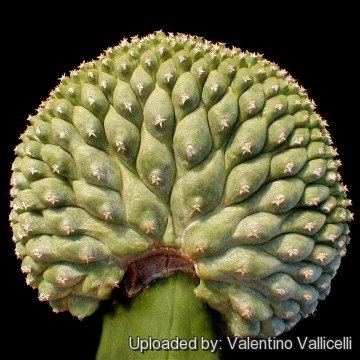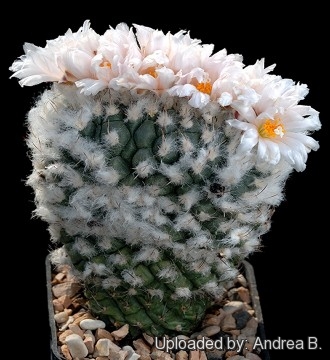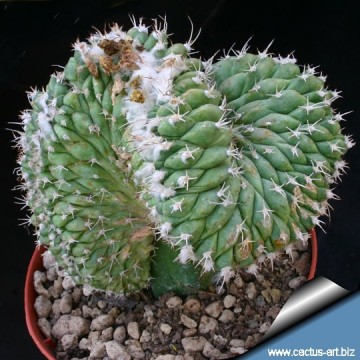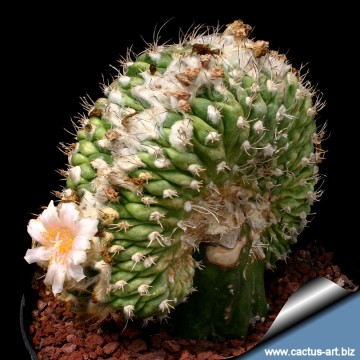Accepted Scientific Name: Turbinicarpus lophophoroides (Werderm.) Buxb. & Backeb.
Jahrb. Deutsch. Kakteen-Ges. 1937, 1st Teil, 27 et in Cactaceae (Berlin) 1937(1): Blatt 27. [25 Mai 1937] (Often misspelled "lophophorioides")

Turbinicarpus lophophoroides f. cristatus Photo by: Valentino Vallicelli
Origin and Habitat: Garden origin (Nursery produced cultivar)
Synonyms:
See all synonyms of Turbinicarpus lophophoroides
back
Accepted name in llifle Database:Turbinicarpus lophophoroides (Werderm.) Buxb. & Backeb.Jahrb. Deutsch. Kakteen-Ges. 1937, 1st Teil, 27 et in Cactaceae (Berlin) 1937(1): Blatt 27. [25 Mai 1937] (Often misspelled "lophophorioides")Synonymy: 8
back
Description: This plant is recognizable without problems for the areoles with white wool (when young), soon becoming bare. Spines 2 to 5 (typically 4) about 4 to 8 mm long, in a cross like formation, strong needle-like or fine awl-like, flat spread and often somewhat curved to the body. There are indeed several different crested clones available in the trade.
Bibliography: Major references and further lectures
1) Smith, M., Fitz Maurice, W.A., Fitz Maurice, B & Sotomayor, M. 2013. Turbinicarpus lophophoroides. In: IUCN 2013. "IUCN Red List of Threatened Species." Version 2013.2. <www.iucnredlist.org>. Downloaded on 07 March 2014.
2) David Hunt, Nigel Taylor “The New Cactus Lexicon” DH Books, 2006
3) Edward Anderson “The Cactus family” Timber Press, Incorporated, 2001
4) James Cullen, Sabina G. Knees, H. Suzanne Cubey "The European Garden Flora Flowering Plants: A Manual for the Identification of Plants Cultivated in Europe, Both Out-of-Doors and Under Glass" Cambridge University Press, 11/Aug/2011
More... Turbinicarpus lophophoroides f. cristatus Photo by: Valentino Vallicelli
Turbinicarpus lophophoroides f. cristatus Photo by: Valentino Vallicelli - This plant blooms freely along the crest line. Photo by: Andrea B.
- This plant blooms freely along the crest line. Photo by: Andrea B. Turbinicarpus lophophoroides f. cristatus Photo by: Valentino Vallicelli
Turbinicarpus lophophoroides f. cristatus Photo by: Valentino Vallicelli Turbinicarpus lophophoroides f. cristatus Photo by: Cactus Art
Turbinicarpus lophophoroides f. cristatus Photo by: Cactus Art Turbinicarpus lophophoroides f. cristatus Photo by: Cactus Art
Turbinicarpus lophophoroides f. cristatus Photo by: Cactus Art Turbinicarpus lophophoroides f. cristatus Photo by: Cactus Art
Turbinicarpus lophophoroides f. cristatus Photo by: Cactus ArtCultivation and Propagation: Turbinicarpus lophophoroidesSN|11693]]SN|11693]] is a plant adapted to a specific type of soil and quite prone to rot especially after the first flowering. A 10 -30% of natural gypsum could be added to a very well drained soil. keep dry in winter or when night temperatures remain below 10° C, it is hardy to -4°C for a short period. Assure a good ventilation. Exposures: Full sun is useful to obtains a natural looking and for flowering, but some shadow is recommended during the hottest hours in summer.
Propagation: by vegetative propagation grafting or stem cuttings.

















